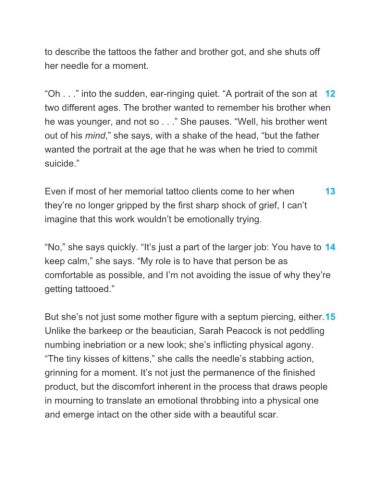Page 1110 - Wordsmith A Guide to College Writing
P. 1110
to describe the tattoos the father and brother got, and she shuts off
her needle for a moment.
“Oh . . .” into the sudden, ear-ringing quiet. “A portrait of the son at 12
two different ages. The brother wanted to remember his brother when
he was younger, and not so . . .” She pauses. “Well, his brother went
out of his mind,” she says, with a shake of the head, “but the father
wanted the portrait at the age that he was when he tried to commit
suicide.”
Even if most of her memorial tattoo clients come to her when 13
they’re no longer gripped by the first sharp shock of grief, I can’t
imagine that this work wouldn’t be emotionally trying.
“No,” she says quickly. “It’s just a part of the larger job: You have to 14
keep calm,” she says. “My role is to have that person be as
comfortable as possible, and I’m not avoiding the issue of why they’re
getting tattooed.”
But she’s not just some mother figure with a septum piercing, either. 15
Unlike the barkeep or the beautician, Sarah Peacock is not peddling
numbing inebriation or a new look; she’s inflicting physical agony.
“The tiny kisses of kittens,” she calls the needle’s stabbing action,
grinning for a moment. It’s not just the permanence of the finished
product, but the discomfort inherent in the process that draws people
in mourning to translate an emotional throbbing into a physical one
and emerge intact on the other side with a beautiful scar.

